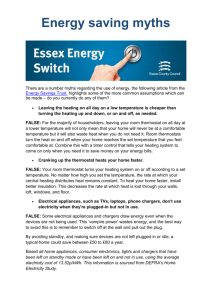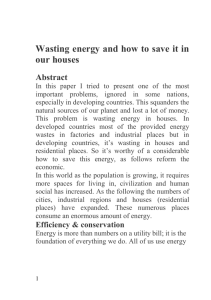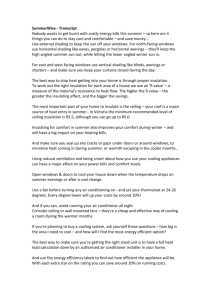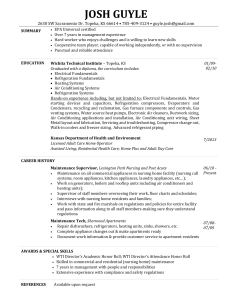ERA Councils draft web content Page title: Easy ways to save
advertisement
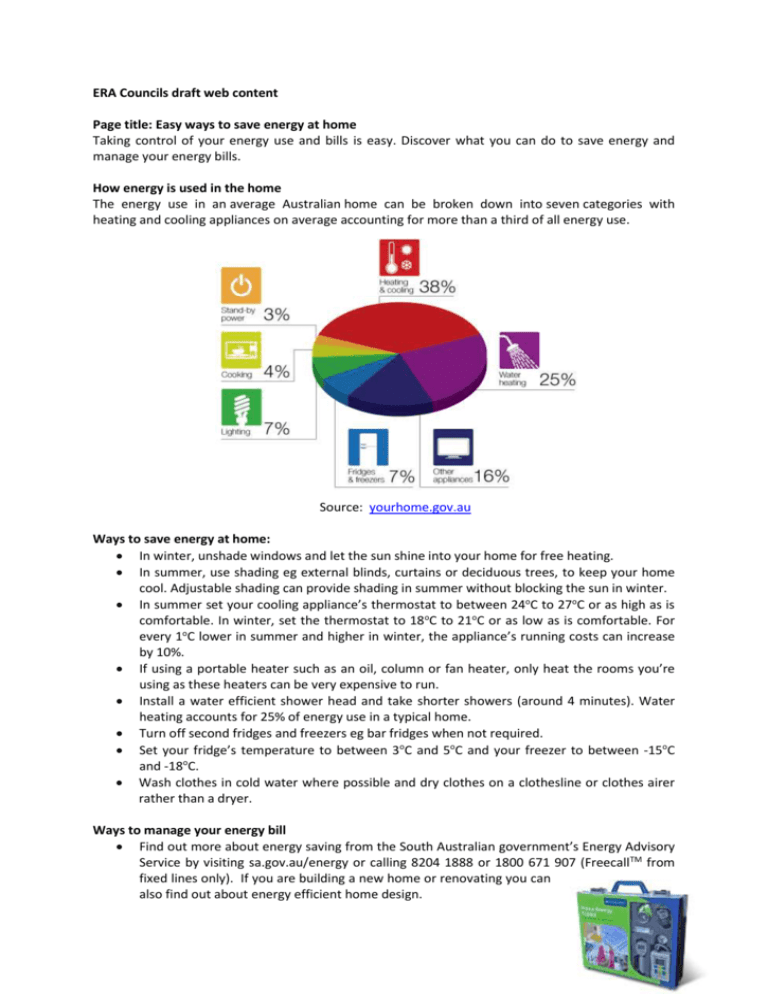
ERA Councils draft web content Page title: Easy ways to save energy at home Taking control of your energy use and bills is easy. Discover what you can do to save energy and manage your energy bills. How energy is used in the home The energy use in an average Australian home can be broken down into seven categories with heating and cooling appliances on average accounting for more than a third of all energy use. Source: yourhome.gov.au Ways to save energy at home: In winter, unshade windows and let the sun shine into your home for free heating. In summer, use shading eg external blinds, curtains or deciduous trees, to keep your home cool. Adjustable shading can provide shading in summer without blocking the sun in winter. In summer set your cooling appliance’s thermostat to between 24oC to 27oC or as high as is comfortable. In winter, set the thermostat to 18oC to 21oC or as low as is comfortable. For every 1oC lower in summer and higher in winter, the appliance’s running costs can increase by 10%. If using a portable heater such as an oil, column or fan heater, only heat the rooms you’re using as these heaters can be very expensive to run. Install a water efficient shower head and take shorter showers (around 4 minutes). Water heating accounts for 25% of energy use in a typical home. Turn off second fridges and freezers eg bar fridges when not required. Set your fridge’s temperature to between 3oC and 5oC and your freezer to between -15oC and -18oC. Wash clothes in cold water where possible and dry clothes on a clothesline or clothes airer rather than a dryer. Ways to manage your energy bill Find out more about energy saving from the South Australian government’s Energy Advisory Service by visiting sa.gov.au/energy or calling 8204 1888 or 1800 671 907 (FreecallTM from fixed lines only). If you are building a new home or renovating you can also find out about energy efficient home design. Ask the Council’s Service Centre or Library staff which energy saving guides and brochures they have available. Borrow a do-it-yourself Home Energy Toolkit from our library and complete a home energy audit. The toolkit’s simple step-by-step process will help you understand and reduce your household’s energy consumption. Look for the best energy deal for you by visiting the Australian Government’s price comparison website energymadeeasy.gov.au or call 1300 585 165. Find out if you are eligible for a concession by visiting sa.gov.au/concessions Talk to your energy provider about spreading your payments. Paying your energy bill in instalments can help you to manage your budget and avoid getting a large quarterly bill. Why is energy saving important? Many households in South Australia are concerned with rising energy prices. If the demand for energy increases, more infrastructure is required with costs passed on to households. By saving energy, the need to provide additional infrastructure can be reduced. Additionally, Australia’s greenhouse gas emissions per person are among the highest in the developed world. By using less energy, you can help to reduce Australia’s greenhouse gas emissions and help the environment. NAME OF COUNCIL is a participating in the South Australian government’s Energy Partners Program assisting households to save energy. For more information visit sa.gov.au/energypartners Page title: Building an energy efficient home Building a new home or extending an existing home is an excellent opportunity to include energy efficient and environmentally sustainable design features. These features will make your home more comfortable, environmentally friendly and can significantly reduce your ongoing energy costs. This page provides some key areas to consider with your builder when you are looking to build or extend. All new homes and extensions built in South Australia must meet minimum energy efficiency requirements. New homes must also meet additional requirements for efficient lighting and water heaters. The council or a private certifier will assess the design of your new home or extension for compliance before you are given development approval and construction can begin. For more information about the minimum energy efficiency requirements or to find a list of registered energy assessors see the South Australia government’s six star energy efficiency requirements for new homes. Some key areas to consider when building or extending are described below, but for more comprehensive information and practical tips on environmentally sustainable home design and construction including questions for your builder and a new home checklist, visit the Australian Government’s Your Home website. Energy efficiency considerations when building or extending: 1. North facing living areas Rooms you spend most time in during the day as living rooms and kitchens are best if they face north, because they get the most sun in winter and can be easily shaded in summer, reducing the amount of heating and cooling you need. Windows and doors that allow for cool breezes in summer can keep your home cooler. 2. Internal doors and rooms Open plan homes will need more energy to heat or cool. Installing doors will allow you to close off areas, so that you can just heat or cool the rooms you are using and reduce your costs. 3. Thermal mass Materials that can absorb heat, such as tiles, brick and concrete, can help with your heating and cooling needs. For example, in winter they can store heat during the day and release it at night. 4. Insulate and draught proof your home Insulation is any material that reduces the amount of heat transfers to or from your home through the ceiling, walls and floor. Insulation is measured by its R-value. When installing insulation, the higher the R-value the more effective it will be. Draft-proofing involves sealing up gaps around walls, floors, doors, window frames and other fixtures. A well-insulated and draught-proofed home will help to keep the temperature inside comfortable and reduce the amount of heating and cooling you need. 5. Windows and shading In winter, let the sun shine into your home for free heating. In summer use shading especially on north, east and west windows to keep your home cool. The right sized eaves can provide fixed shading, while adjustable shades, awnings and deciduous trees can shade in summer and still allow the sun to enter the home in winter. Double glazed windows or thick curtains with pelmets reduce heat transfer through windows. 6. Heating and cooling appliances Heating and cooling appliances are the largest energy users in the average Australian home. Choosing the most energy efficient and appropriately sized heating or cooling appliance will help to reduce your home’s energy use. 7. Lighting If you are considering downlights, holes will need to be cut in the roof insulation for the downlight fitting in the roof, reducing the insulation performance. Consider alternatives such as pendant lighting or ceiling mounted spots. While skylights provide more natural lighting, they can also increase heat transfer through walls or ceiling. If you need a skylight, consider one that is well insulated. 8. Water heaters and other appliances When choosing household appliances, make sure you choose energy efficient appliances that are the right size for your household’s needs. Major appliances like fridges/freezers and TVs have an energy rating label on them to show how much energy they use. Use the labels to compare similar-sized appliances. Alternatively, the Energy Rating website provides a comparison service for appliances with an energy rating label. The more stars, the better. When installing a new water heater or replacing an existing one, choose an efficient model such as a solar, high efficiency gas, or heat pump system. Checks after building is completed Once your building or extension is complete, use the first few months to check that the energy efficiency features of your home have been constructed correctly and are performing as expected. Check, where possible, that insulation is correctly in place after all the various trades have completed their work. Also look out for unintended gaps in joints between different materials (such as walls, floors, doors, window frames and other fixtures). These can cause ‘air leaks’ that will reduce the energy efficiency of your home. The best way to check for these is to engage a specialist to use thermal imaging cameras, blower door testing equipment and other systems to check on the buildings overall thermal performance. Discuss any problems you find with your builder, as your building contract is likely to have provisions for correcting defective workmanship. More information and advice The South Australian government’s website, sa.gov.au/energy, provides further information on energy efficient home design and appliances. Contact the Council (insert Council details) for more information energy efficiency housing requirements and the process. Page title: Energy efficiency for businesses Reducing the amount of energy your business uses could help your bottom line. For South Australian small businesses, many household energy saving tips can help reduce energy consumption (for example, installing energy efficient lighting and reducing computer and office equipment energy use). The South Australian government offers a range of energy saving advice online at sa.gov.au/energy For more information and advice on energy efficient practices for medium and high energy using businesses, including best-practice information on energy efficiency, case studies and national and international resource materials see the Energy Efficiency Exchange (EEX). A professional energy audit of your business may identify particular areas where your business can save energy and reduce energy costs. Look for business energy audits online or in a telephone directory. In South Australia there are a range of services available to help businesses become more energy efficient and sustainable. For information on these programs, see the South Australian government’s website sa.gov.au/energy

